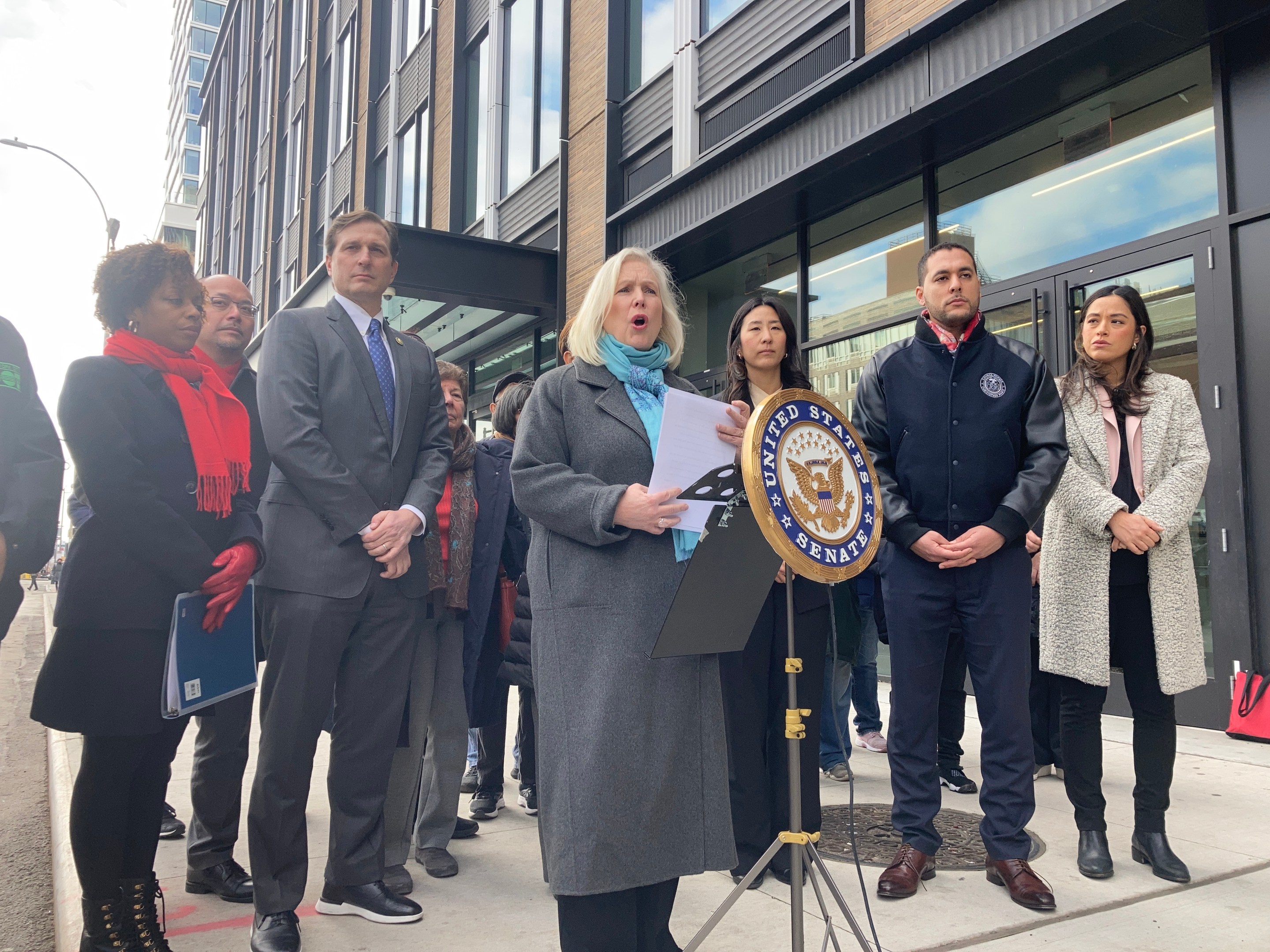Ignorance is bliss.
Sen. Kristen Gillibrand on Monday joined fellow federal, state, and local pols to announce an $18-million federal grant to redesign dangerous Delancey Street with accessibility upgrades, a separated bike lane, and a road diet — but New York's two-term senator didn’t know what a road diet is.
Gillibrand referenced 12-year-old Dashane Santana, who was killed while crossing Delancey Street in 2012 in announcing the multimillion project, and said it’s time New Yorkers feel safe on the deadly corridor. The $18-million project for Delancey Street, which already has a two-way cement-protected bike lane, will consume roughly 85 percent of the federal $21-million citywide grant for improving safety.
Since 2019, there have been 799 total crashes on Delancey Street between Bowery and Clinton streets, causing 279 injuries, including to 69 cyclists and 48 pedestrians (one of whom died), according to city stats. But the number of injury-causing crashes has remained steady since the installation of the protected bike lane, despite large increases in cycling.
Still, Gillbrand said, “We need to do much better,” as Rep. Dan Goldman (D-Park Slope); Council members Selvena Brooks-Powers (D-Queens), Chris Marte (D-Lower Manhattan), and Carlina Rivera (D-East Village); and Assembly Member Grace Lee (D-Lower Manhattan) looked on. “Critical improvements will be made along this corridor, including the development of separated bike lanes, accessibility upgrades, a road diet, along with other safety upgrades that will have a lasting impact across New York City.”
But when asked for more details for a strip where the city already installed a protected bike lane in late 2018 and made other safety improvements following Santana’s death, Gillibrand couldn’t quite say.
“There’s gonna be a development of separated bike lanes, gonna be accessibility upgrades so to make sure the people who need accessibility can get to the crosswalk without having to endanger themselves. … I don’t know what a road diet is, do you know what a road diet is?” she said, looking to her nearby colleagues for help, despite the phrase just minutes before being in her own remarks.
A spokesperson for the Department of Transportation chimed in, saying that a road diet “reduces the width of the street to calm traffic naturally.”
Gillibrand then called it “interesting.”
“So that's interesting, a road diet is to narrow the street so less vehicles can go on it,” she said.
But the senator's ignorance shows how much more advocates need to do to break through politicians' windshield perspective to understand how to cure the epidemic of road violence that claims 43,000 Americans every year — plus a rising number of cyclists and pedestrians due to the increasing size and weight of cars.
"We have to do in terms of educating people and creating a mind shift," said Sara Lind, chief strategy officer at Open Plans (a sister organization of Streetsblog). "Even the people who say the right things are still kinda stuck in that car-centric space where all they think about is moving cars around, they don't even know what at a road diet is because it never occurs to them we want to get cars off the street."
(Road diets are particularly controversial in neighborhoods where politicians wish to appear to be acting in the interest of car owners, even though a proper conversion from two lanes in each direction to one lane in each direction with turning bays can actually reduce congestion. Nonetheless, politicians frequently oppose them.)
👏 👏 Thanks @SenSchumer for continuing to direct federal $ to sustainable streets & looking out for #bikenyc! This funding will create a robust permanent bikeway on Delancey Street https://t.co/kMBVzcwWbp
— Bike New York (@bikenewyork) February 6, 2023
The city already installed such a “road diet” on the south side of Delancey Street when it created the two-way protected bike lane. Still, Delancey Street, from the foot of the Williamsburg Bridge to the Bowery, remains a high-crash corridor and is a crucial connection for both cyclist and pedestrians, according to according to DOT Commissioner Ydanis Rodriguez, who added that more money is needed for similar safety improvements across the city that have otherwise been underinvested in.
“We need more money ... to address the most dangerous section here, this is a critical stretch," Rodriguez said. "This is a citywide commitment to continue improving safety for pedestrians and cyclists across the five boroughs.
The project is still in the design phase, but the third iteration of safety upgrades to Delancey Street will include concrete build outs, as well as widening the center median and building a grade-separated bike lane so that cyclists are no longer traveling on the roadway — something along the likes of Flushing Avenue or Tillary Street in Brooklyn, or even Allen Street, which runs perpendicular to Delancey Street.
According to the DOT, the city will also simplify the “street geometry" for drivers.
The enhancements will completely “change the feel” of Delancey Street, making it “safer and more welcoming,” according to Rodriguez.






